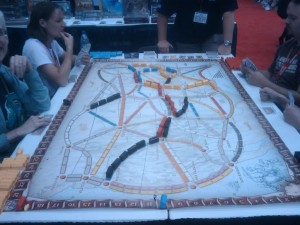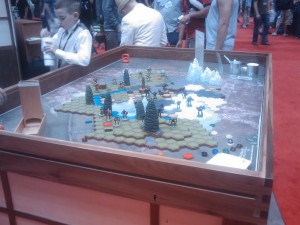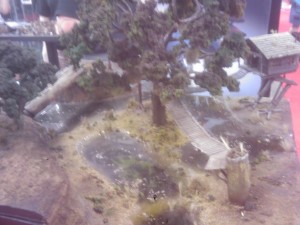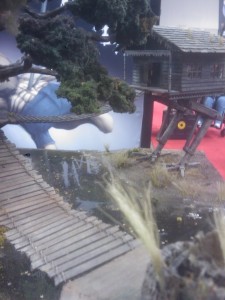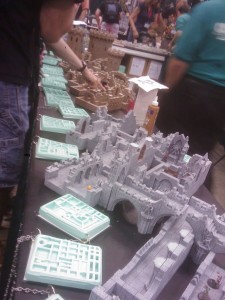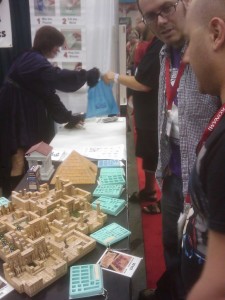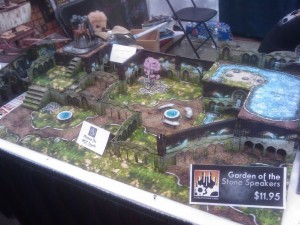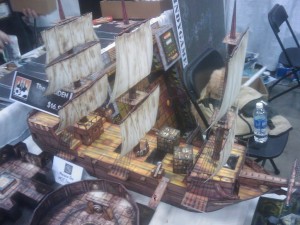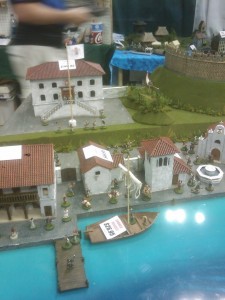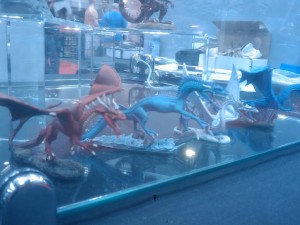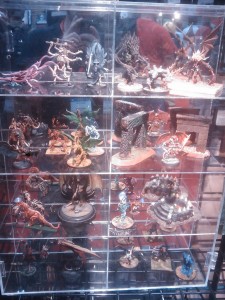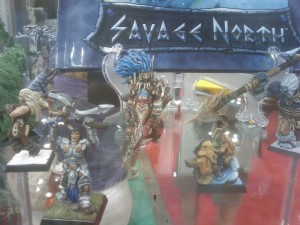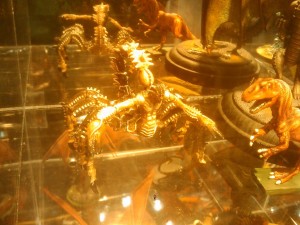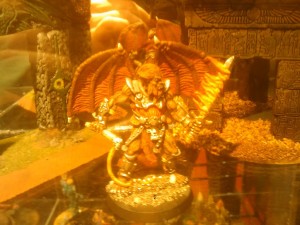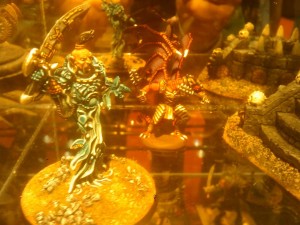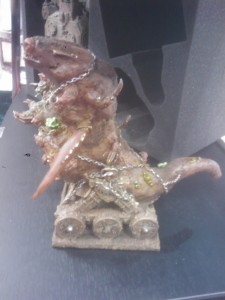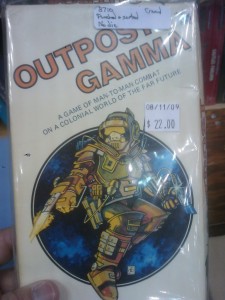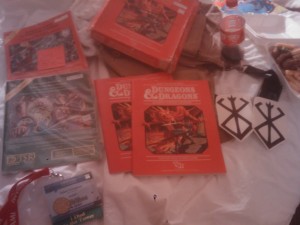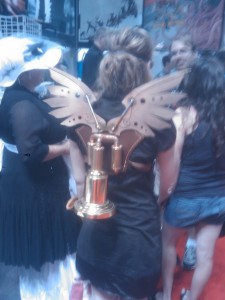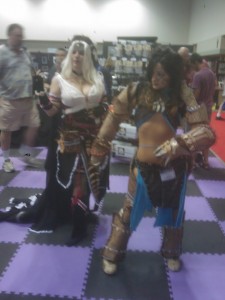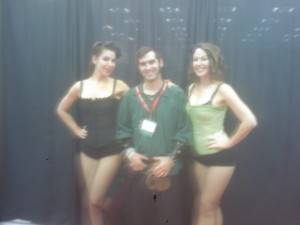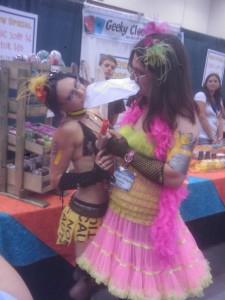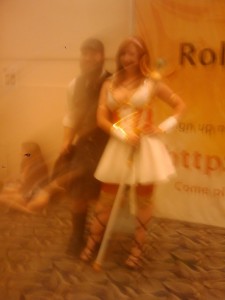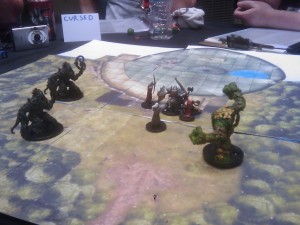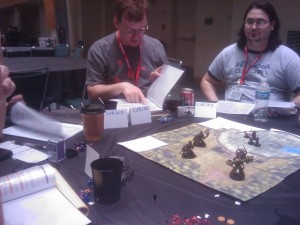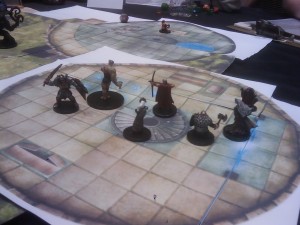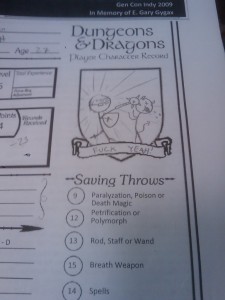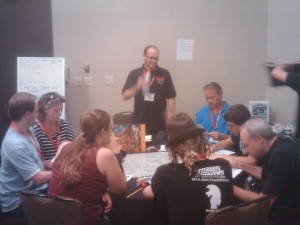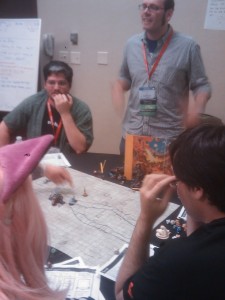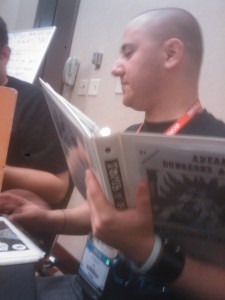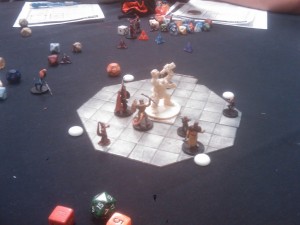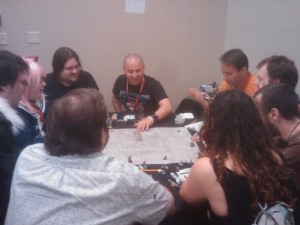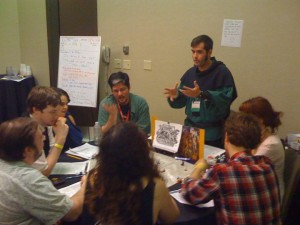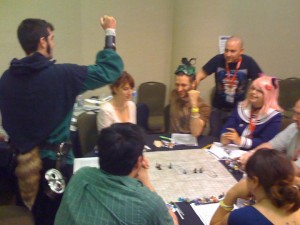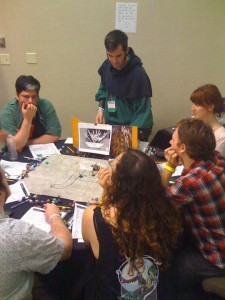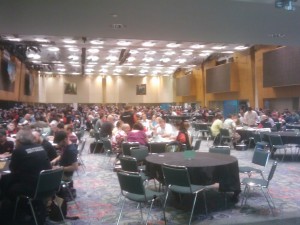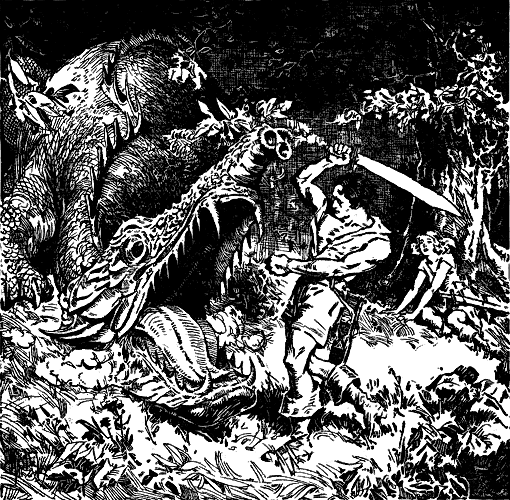Space Opera – Season 3 – Deepest Darkness
Having crossed the length and breadth of the Skein Reach
nurtured a nascent Droid Uprising
faced off against, and robbed
the Imperium, and the Ragranok Krew
made enemies innumerable
and killed many
and in the process saved many from death and from fates worse than death
the motley crew of the starship CALAMITY
navigate ever coreward
following the impulses of a strange cyber-brain
and a pieced-together map from a lost star empire
past dead star after dead star
attended by tiny chunks of rock
(each gathering sufficient hydrogen from the bright strands of bright, colorful nebulae to allow refueling)
find
nestled in the glare of a deadly pulsar
a blank globe
of deepest darkness.
Posted in Lore / Worldbuilding, Science-Fiction, Traveller, Uncategorized and tagged ale break, Skein Reach, worldbuilding by Adam A. Thompson with no comments yet.
GenCon 2010
I’m just now getting a chance to write about the great time I had at GenCon this year, but I wanted to make sure y’all saw the pictures I got of all the great games, costumes, and miniatures I got. So welcome to Unicorn Rampant’s virtual walking tour of GenCon 2010!
Games and Minis
In the “big tables” category, I saw a giant version of Ticket to Ride that looked like a lot of fun. Also present but not pictured were giant Settlers of Catan and a few other giant versions of some great board games.
Costumes
Games
And of course, I played a lot of games at GenCon this year. In years past I had made a point of trying to promote Unicorn Rampant, either by meeting people in the industry that we have partnerships with, like Paizo and RPGnow, or by running games. Of course that meant I was either exhausted or missed out on having fun playing myself. This year I tried to maximize the fun by playing as much as I wanted to, and giving myself breathers between games if I wanted. As a result, I had the most fun this year that I’ve had a GenCon.
I played some great RPGA games – the Ravens of Winter’s Mourning game was lots of good investigative fun, and the Curse of the Gray Hag was simply awesome. Here are a few pics from the Curse of the Gray Hag game.
Posted in convention and tagged ale break, GenCon by Adam A. Thompson with no comments yet.
Red Nails – a Classic Tale of Conan
Among fantasy gamers of my generation, Conan the Barbarian stands as one of the best fantasy movies ever produced, along with Dragonslayer, Legend, Fritz Lang’s Sigfried, and a few others. But even John Milius and Dino DeLurentis’s masterful screen adaptation of Robert Howard’s tales of Conan pales in comparison to the original stories.
Now, Project Gutenburg has made available to the public one of the most gripping adventures Conan faced, Red Nails. Originally published in 1936’s Wierd Tales magazine.
Enjoy this thrilling tale of adventure here: http://www.gutenberg.org/etext/32759
Posted in Review and tagged ale break by Adam A. Thompson with 3 comments.
Ale Break: 24 Hours in Faerun
Update: more OwlCon photos available here!
I just spent 24 hours in the Forgotten Realms, and boy am I tired!
This weekend Steve and I packed up our PHBs and trekked on over to Houston for OwlCon 2010. We left early Friday because I wanted to play some D&D, actually I wanted to play a lot of D&D, and I got what I wanted!
When we got to Rice University, where OwlCon is put on, we were really pleased at how well organized everything was. Steve had the foresight to book a hotel just a few blocks from campus, so every day started and ended with a nice walk across their stately campus to the buildings where the games were. Inside, we got our packets, peeked into the exhibit hall, noting the Battletech Pods with excitement, and made our way over the the building where the RPGA games were held.
Now, in my experience, with the exception of GenCon, RPGA is the red-headed stepchild of convention events. That is to say the RPGA events tend to get shuffled off to a corner of the convention, and I usually get the impression that the convention organizers either don’t really care too much about them, or, at some historical-miniatures-focused conventions I could name, seem downright hostile towards them.
OwlCon was different. When we arrived at the nice large room the RPGA events were in there were plenty of comfortable chairs and large tables. I was directed to the Houston RPGA organizer and right away started to have my socks blown off. My pre-registeration on Warhorn was indicated on his printout of all the weekend’s games, he directed me to the GM for my game, and we sat down and started playing. We didn’t have to stand around for an hour trying to muster, we didn’t have to fight other players for a GM, we just showed up and started playing. Pow.
And that was just the start. On Saturday the morning slot started at 10 AM instead of 8 AM, as one often sees at a con. That meant we got a good night’s sleep and didn’t have to rush breakfast or run like mad to catch our games. Steve headed off to play some Advanced Civ and Rail Baron, while I put on my dragon-skull helmet and headed back to Ferun for more bloody fun.
As a side-note, I’ve always been a Greyhawk fan, and was a little disappointed to see it replaced by Forgotten Realms by WoTC. But I really liked the stories that they ran this weekend. The organizers had put a lot of work into the scenarios and it showed. The adventures dove-tailed into each other and after an adventure or two you really had the impression that you were in a living setting where your actions would have an effect on what was ahead. They even played a round where the player’s success or failure at the some tables affected what was happening at the other tables.
After my elven barbarian got his ass handed to him by were-rats (actually, a total party kill) the organizers went around and got sandwich orders from everyone from the campus deli. 30 Minutes later lunch arrived. That meant we didn’t have to rush to wrap up our game, run off to find some lunch, and run back to make the next slot. This convention had a very atypical relaxation component to it that I could really get used to. I pretty much couldn’t believe it.
After the third slot of the day finished at midnight we strolled over to the dealers room, perused the wares on display, and played a round of the Battletech PODS, which I had never had a chance to try before. It was every bit as fun as I imagined it would be. I was once again impressed by the fact that the dealer’s room didn’t close up at 7 pm or so as is typical at previous conventions I’ve been to. Usually, even at GenCon, I have to decide between playing a game or skipping something to shop at the dealer’s room. Not so at OwlCon.
Sunday followed Saturday’s great lead with more of the same: friendly, if tired, GMs and players playing two more slots of RPGA events. At the end of the weekend my elf was 3rd level, I was tired and satisfied, but not frazled or exhausted as is ofter the case after a con, and we headed on home to Austin. We had met a bunch of great players and GMs from all over Texas, and we had hit the monsters until the gold came out.
I’m already looking forward to OwlCon 2011. Thanks for a great time, guys!
Posted in convention and tagged ale break, news: convention by Adam A. Thompson with 4 comments.
Brevity vs. Bloat
I just read Wolfgang’s editorial “Keep it Short” in the latest issue of Kobold Quarterly. In it he extols the virtues of short books with lots of impact. I don’t disagree with him – short and clear is good – but his article rails against long works as though they are bad in and of themselves. Maybe he’s used to seeing writers pad their word count excessively because they’re payed by the word.
In any case, his editorial got me to thinking about the subject of word count, brevity, and bloat and about how I approach writing RPG supplements, specifically in regards to what I see as one of the biggest pitfalls in RPG writing – skimming over material the DM needs to run the adventure.
When I write an adventure I have several goals in mind. Of course, I want it to be fun, fantastic, compelling, believable and exciting. That almost goes without saying. Beyond that one of my number one goal is to make my adventures easy for DMs to run. I want my adventures to leave a casual or first-time DM and their players saying “that was great!” instead of wondering how to start.
In my many years as a player I’ve read lots of adventures. Some do a great job of laying out the adventure for the DM, other less so. The bad ones are the adventures that have weak introductions or transitions, and require the DM to ad-lib or completely make up sections of the adventure to keep the story moving along. Many DMs are up for this task, but for many DMs, especially new DMs with less experience, being left hanging by the adventure you’re trying to run can really demoralize you. I feel like this just adds to the steep learning curve that new DMs face, and I want Unicorn Rampant to produce adventures that ease this learning curve, increase the fun everyone is having, and help the hobby grow.
To that effect, when I write an adventure, my goal is to provide the DM with everything he needs to present the story from start to finish. Many DMs may not use all of this material, especially the hook or introduction material. But for a first time DM, I want to make sure they have something that they can use to get the action started without having to rely on telling the players that they’re all gathered at the inn and see a wanted poster. Remember, not all of us are in the midst of playing epic campaigns. Many players, especially those new to the hobby, can really use a way to get the story rolling easily.
Now, including summaries of the course of the adventure and read-aloud text for every transition and important location in the adventure can add to the word count, but all of it is included for a purpose. Organizing it cleanly and keeping the summaries brief and clear is all part of making the adventure easy to run. If that adds to the word count, so be it. I would rather provide DMs and players with more than they need then not enough.
-Adam A. Thompson
Posted in Uncategorized and tagged about Unicorn Rampant games, ale break by Adam A. Thompson with 1 comment.
Ale Break: Keep on the Borderlands
It all started when I ordered a copy of the AD&D adventure “Vault of the Drow”. I like to read over these old modules and see how the original writers of this game conceived adventures. I was so taken with “Vault” that I also got “Descent into the Depths of the Earth”. I liked them so much that I decided I wanted to run or play in them. But with the two weekly games I run in mid-progress I felt like I was pretty much booked up.Wednesdays we play “Savage Tide”. At 16th level, they’re in the home stretch: 4 more adventures to go, and I don’t want to lose momentum on this game.
Sundays I run a D&D game for some friends and co-contributors to Unicorn Rampant. I’ve been running a homebrew campaign I call “The Heir of Soguer”, but have had a little writer’s block lately. So I thought, here’s a chance for us to take a little break from “Heir” and revisit some old adventures I haven’t played since high school or have never had a chance to play.
So far it’s been a blast running “Keep on the Borderlands”. I came up with a place to put the keep in my campaign world and told the players the story was taking place 10 years before the story I’m telling in “Heir”. I then told them they were from the Temple of the Stars, a historically important location they’re headed to in “Heir” and worked on backgrounds for their characters. I then and gave them their quest: go to the Keep on the Borderlands, where bandits are raiding travelers, and lend a hand however they can. This gave me a way to tie this side trek into the current game: it gives the players some foreshadowing of what they’re about to encounter in “Heir”. The quest is also the type of cheesy, simple old-school adventure hook that gave the game a great starting flavor.
It’s been wonderfully nostalgic running Keep. The players got to the famous “Castallian Keep” and started wandering around, meeting the locals and soaking up the medieval flavor.
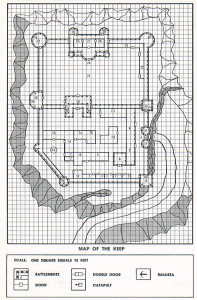
I had to come up with names for all the NPCs, since that’s the one detail omitted from the town descriptions. For those who have never seen Keep on the Borderlands, there are elaborate descriptions of lots of things, including the contents of every drawer in the moneylender’s shop and the traps guarding each drawer, but the people there are “scribe: mu2, ac:9, at:1, dmg: 1-4, spells: ventriloquism, grease”. And you thought 4e stat blocks were short 🙂 All together the adventure is about 20 pages with the area descriptions, treasure, hidden features and stats all run together in a single paragraph for each area. Adventures have come a long way in 30 years, although you still sometimes see this.
Once they got to the Caves of Chaos and started in on the meat of the dungeon, I started converting the encounters on the fly. According to the 4e DMG, each 1st level character in the encounter merits 100 xp worth of monsters, up to 175 xp for a really tough challenge. The adventure says there are 6 goblins in the first room, and I have 3 players. So I went with four goblin minions at 25 xp each, and two 1st level goblins at 100 xp each for a total of 300 xp worth of monsters. If there were only 3 goblins called for I made them all 1st level goblins at 100 xp each, or two 2nd level at 150 xp each and a minion for 25 xp. It worked out quite nicely; I was able to run the adventure from a single page in the monster manual, so there wasn’t a bunch of flipping around from book to book. Between this and buying 14 goblin minis this kept the players from guessing who were minions and who weren’t.
All of this made me think about how simple the monsters were in AD&D. They had a HD, which determined their “BAB”, and a number of attacks and damage. They also had a morale score, and if they were special they had a “saves as” entry. Unless they had spells or special abilities, that was it. Compare that to the 3e stat block for a goblin: 23 lines of information jammed together in a poorly orgznized format. Of course, that format was inherited form the old AD&D monster manual. Paizo improved drastically on the readability of that format in their Dungeon Magazine by organizing the stats in sections, and we use that format here at Unicorn Rampant for our Claw/Claw/Bite! line of products, but there can still be a lot of digging around required of the DM compared to having only 5 or 6 numbers as stats for a monster. Now, in 4e, you can almost run all your monsters from a single chart again. I keep thinking I’m going to write up a spreadsheet that takes monster level and role and spits out complete stats.
For running the dungeon I used our big Chessex mondomat, as usual, and tried out the Dungeon Mastery dungeon tiles from Piazo that I got at GenCon last year. I was really happy with them: they add a lot of good-looking detail to the game without taking a lot of time to draw. Lack of good corridors is the only real weakness of the tiles, but it’s easy enough to draw the corridors and use the tiles for the rooms along the way. I’m thinking I’m going to pick up another set or two and copy some of the corridors in the back of the DMG for the next session.
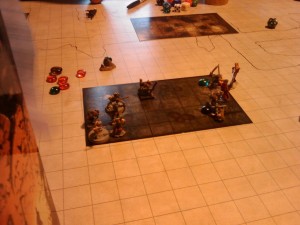 I just got all three modules of the “Against the Giants” series, so hopefully we’ll keep enjoying these old adventures enough to string together a campaign out of them.
I just got all three modules of the “Against the Giants” series, so hopefully we’ll keep enjoying these old adventures enough to string together a campaign out of them.
Thanks to W.o.G. for inspiring me to get “Vault of the Drow” and sending me down this old path once again.
-Adam
Posted in Editorial and tagged ale break by Adam A. Thompson with 2 comments.
Manners, Customs and Dress During the Middle Ages
I just found this book on the Project Gutenburg site, and wanted to share it. It’s currently the #5 most popular book on the project’s site.
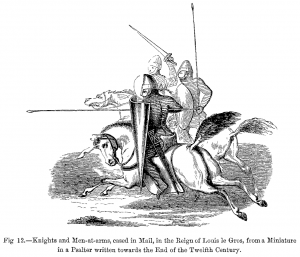
Although most modern games gloss over historical cultural and political structures, as a student of history I find the minutiae of such fascinating. Occasionally I will find something that I can write into a game that gives flavor, and sometimes it becomes a major underpinning of the story. For example, in “The Heir of Soguer”, the system of vassalage is really central to the story. I’ve tried to engage the players in that by having it brought up by NPCs, making it the source of the current major conflict in the story, and even knighting the player’s characters in the game. All of this has been wonderful detail that helps create a historical feel for my game, as well as informing the central conflict.
I’m hoping that this book yields more of such wonderful details. It has more than 400 woodblock prints, as well.
http://www.gutenberg.org/files/10940/10940-h/10940-h.htm
Posted in Uncategorized and tagged ale break by Adam A. Thompson with no comments yet.
Ale Break: Debunking the Role-playing vs. Roll-playing dichotomy
I would like to take a moment to debunk the often-touted Role-playing vs. Roll-playing argument.
Let me start by saying that there are many things about RPGs that are enjoyable. There’s getting together with your friends and having social time, joking around, catching up. In most RPGs there’s also a significant tactical or combat game aspect to them – RPGs without a heavy focus on combat in the rules are the rare exception. Then there’s what many consider the holy grail of RPGs – the actual role-playing.
In my decades running and playing role-playing games, I have seen players that are good and bad at both. Sure, I’ve seen the powergamer who can’t come up with a name for his character. I’ve seen the roleplayer who lives for a well-developed, consistently played character – rarely. I’ve even been in a few games where I made characters purely for their flavor, ignoring what would make them effective within the rules, and not been able to get into character properly – I’ve been bad at both role and roll at the same time.
I’ve seen players that complain about the lack of role-playing in games completely fail to do any role-playing when presented with attempts to engage them directly.
And I’ve seen the player that is not much of a role-player and who’s characters are very effective within the rules turn into quite a role-player over time.
Some players are easy to engage, others not so easy.
It’s a given that in any game there will be people who are better, or more interested than others, in making characters that are powerful. Even in game systems like Amber, where there are almost no game mechanics, someone who is good at it can dominate the other players in overcoming the challenges presented. But that’s going to be the nature in any game: humans are very clever monkeys and will always be looking for better ways to succeed at what they do.
I think that setting expectations in games, both as a player and a DM, is much more important in determining how much role-playing is seen at the table than how good someone is at making characters that are very effective within the rules.
I had an interesting experience the other day. I wasn’t feeling up to DMing on Sunday, so Dan graciously ran a pre-written adventure on the fly. I made a 4e version of one of my reoccurring characters, Kylissa Flamebraid – a female dwarven sorcerer, who’s kind of a teenage runaway, rebelling against her father, with a magic powers she inherited from her maternal grandmother (usually skips a generation in dwarves). I have a small stock of characters I’ve worked out the backgrounds of because it takes me a while to come up with new ideas, and Kylissa is one of them.
Because it was a pre-written adventure that Dan was running on short notice, we were mostly sticking to the canned text and not doing a lot of role-playing. But a number of times during the adventure I found that if I stuck to talking in character, espically when talking to the other players about events in the adventure, they tended to respond in kind.
I’m going to try to find a way to gently encourage everyone in future games to stay in character. Roleplaying cam be a very contagious type of fun, and the more I have in my games the better I like it.
So, to those who are endlessly complaining about those who come only to “roll-play” my question is what are you doing, as a player or as a gamemaster, to draw those players into their roles, or to help them develop them?
Posted in Uncategorized and tagged ale break by Adam A. Thompson with 2 comments.
Ale Break: Questing for spells
One way to add some meaning (and difficulty) to spell-casting is to require spell casters to learn their spells in-character. Some characters may have a formal tutor, but many others will likely not, especially if they are sorcerers, woodland casters (druids, rangers, less-structured clerics) or rogue casters.
For these characters, there is a great way to make them (and their players) really respect and cherish their spells. Make them quest for them! Here are a few ideas.
* The party learns about an ancient tome containing a story about a historical figure who could disappear and reappear across town almost instantly. They decide to track down the tome, which leads them into a large city or the Plane of Knowledge (giant library, the size of a plane, with all known knowledge within — see upcoming CCB post) for more information.
* Someone in the party is killed or otherwise rendered incapacitated (due to an expected player unavailability for the next few sessions), and the rest of the party needs to gather the rare reagents to create the ritual environment for a raise dead, remove curse or similar to be successful.
* A young apprentice wants to learn the invisibility spell, but in order for his master to feel that he has learned the spell, she will hide the scroll that must be scribed in a secret location, and the scroll itself is invisible. The apprentice will need to locate the scroll, and this earn the spell, before he will learn the spell. The master might quip, “First you must know what it is like to be on the other side before you are mature enough to wield the spell.”
* A high-level spell is spread across multiple scrolls, which have been sent via courier to the princely barons of the land. Only by convincing these royals to hand over their parts of the scroll will the party acquire the spell, which happens to be, for instance, charm monster. This may require the party to perform tasks and take on quests for each of the barons, leading to even more adventure!
More to come in a future post…
Posted in Editorial and tagged ale break, dm tips by Stephen Hilderbrand with no comments yet.
